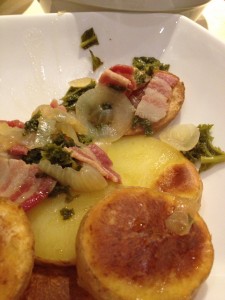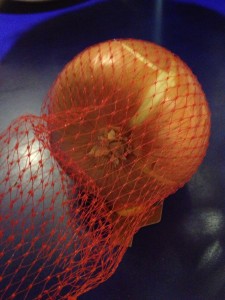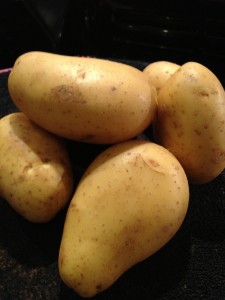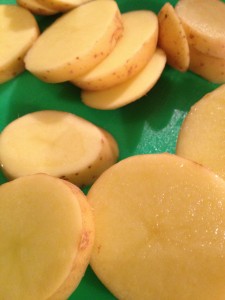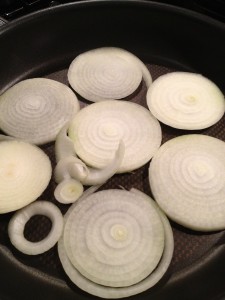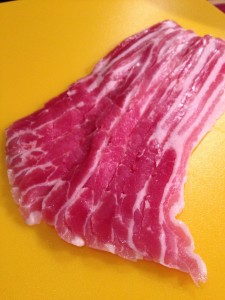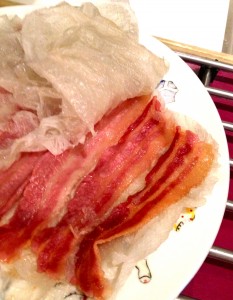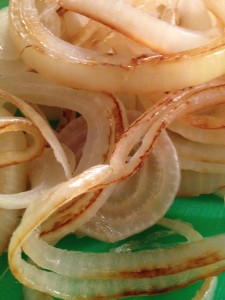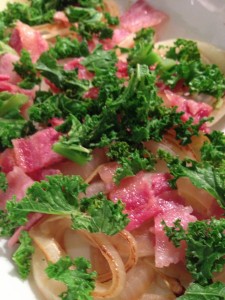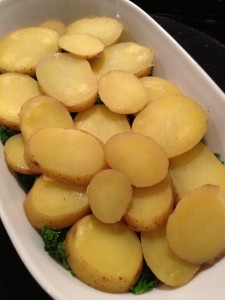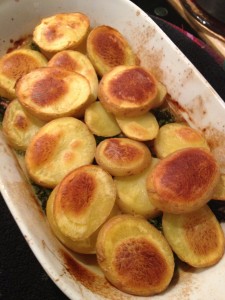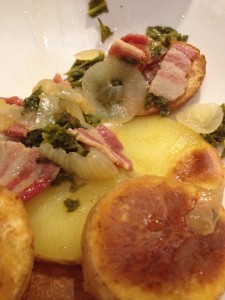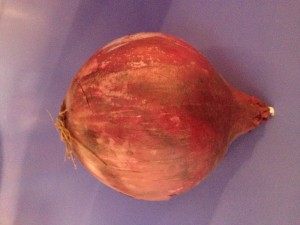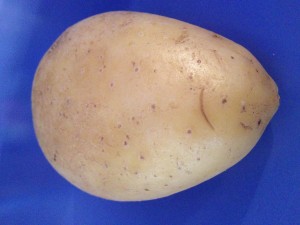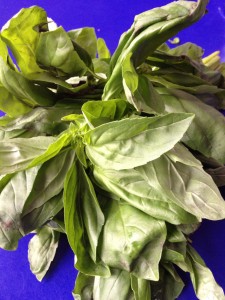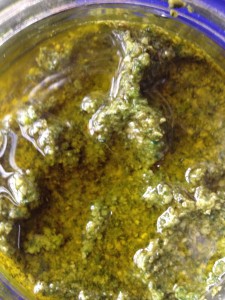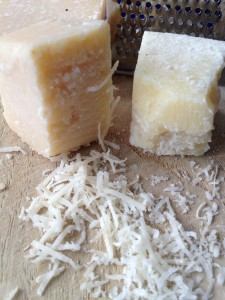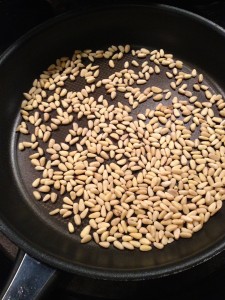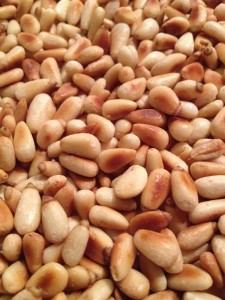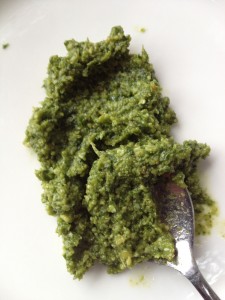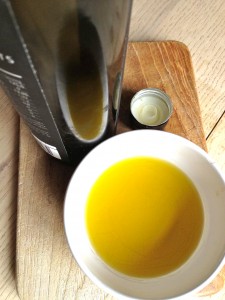For The Mother and her sisters growing up in poverty and lack of facilities of a kind unimaginable to anyone these days, there was an attitude towards food that became ingrained in their minds and has never really left them. Born during, or at the tail end of, the war they were ruled by rationing for many years (till as late as 1954 for some products) and they grew up feasting on a single egg a week and a handful of sweets. Subsequently they evolved an attitude to meat that is very different than that today. A commodity so scarce and so expensive meant working around the lack and still filling hungry tummies. You took what you could get and ruddy well enjoyed it. The girls did rather draw the line at whale meat and, although it was touted as the answer to all their hunger prayers, it went into the cat.
When I asked The Aunt about food memories she remembered this dish that they had as youngsters and continued making into married life. The Aunt said, ‘something we did have in Hulme which I doubt it was given a name then (so I, Mathew, have dubbed it ‘Hulme Hotpot’), but I saw a very similar recipe in a magazine some years after my marriage and it was called Colcannon. Generally, a mixture of potatoes, cabbage and meat. Mum used to boil potatoes – I can’t now remember whether they were sliced first – and cabbage (in separate pans), then the cabbage was laid in an ovenproof dish (we had the now-old fashioned enamel ones in brown or white) covered with the potatoes, a little salt and pepper added, then some bacon, having been fried in the meantime, these rashers were cut up and sprinkled in with the cabbage/potato, and the fat of the bacon poured on. We had decent bacon then too, not in plastic wrappers with water! This was then put in a hot oven just till the top had browned. It was comparatively cheap to make and a tasty satisfying meal.’ Yum, with bacon fat poured over it?!? So wrong it’s almost right…
Incidentally, Colcannon is technically just kale (Savoy cabbage at pinch) shredded and mixed into creamy mashed potatoes with seasoning and a few chopped spring onions.
Anyhoo, I’m updating the recipe (such as this is!) to this version to suit my tastes but hopefully hang on to some of the original feeling:
However, taking only a handful of ingredients and not adding heaps of seasonings or faffing about with them seems to be an idea I’m uncomfortable with. Dunno what that says about me really but I definitely feel there is an edge of nerves about making this simple dish and the outcome. So, at risk of being all life-coach-y, I stop and ask myself what I’m feeling and why. I’ll be honest (it’s best when therapising…the truth will set you free) and say I feel that the dish might be bland and I don’t trust that the ingredients will be enough by themselves. I keep using the fact that I’m doing this as an experiment, as an excuse for the potentially boring outcome. This in turn resonates back to The Mother and The Aunt’s upbringing, implying I feel pricked with issues of guilt and sadness that they had an uninteresting and impoverished nutritional childhood…okay, I said I would NOT dive into a vat of self-therapy, didn’t I? SO…brushing all the ‘feelings’ aside (not a very good therapy result) I press on….
Slice the potatoes and par-boil them. Slice the onion and because, as ever, I’m conscious of adding unnecessary unhealthy elements, I just sautéed the onion slices in a non-stick frying pan and I trim the bacon fat off too! I’m feeling lazy this day so I microwave the bacon…
…I know that sounds odd but placing it between some greaseproof paper (I use kitchen towel as I’ve never got any greaseproof paper!) and nuking it for a good three or four minutes produces a lovely crispy bacon.
Assemble the ingredients in a deep sided oven proof dish. I break the onions up and put them in first. Crumble the bacon over this. Press a good few handfuls of the chopped greens (I’m using kale as it’s seasonal, inexpensive and packs one hell of a nutritional punch) onto this but be aware it will cook down (so add more), and then cover this with the rounds of par-boiled potatoes.
Add the stock by drizzling it over the potatoes. The amount you add depends completely on what texture you want to end up with. A scant perfunctory addition will lead to a drier final product (it evaporates quite quickly in the oven), so I added about a mug full but not so much that it covered the potatoes. This meant the potatoes steamed but browned beautifully and yet the mixture below was wonderfully moist. I chucked it in the oven (Aga actually) at about 200 degrees and cooked it till the potatoes went crispy brown. The basting of the stock at the start is enough to do this. No need to brush with oil or butter etc. – just let the magic happen.
And it is magical. Delicious. It shows that over seasoned, too salty or generally over complicated dishes are making me forget that a few basic and simple flavours, each allowed to shine, makes for a most delicious dinner…
I tried a ‘Sunday roast’ version of this where I put, in this case, the remains of a roast chicken in the base of a casserole dish then layered all the remnants of the vegetables (broccoli, carrots, parsnips) and then topped this off with sliced roast potatoes and covered the lot in the last of the gravy. Slung it in the oven till it reached the ubiquitous ‘piping hot’ and it was good I can tell you! So now I always do a few extra of everything…!
Nutritionally speaking Kale is a super food. Less popular than some of it’s leafy cruciferous brothers and sisters, it is still relatively cheap and, as its seasonal availability is autumn and winter, it provides a wonderful opportunity to get a good amount of vitamin C through the colder months. It’s also packed with system cleansing fibre and sulphur, calcium (more than milk!), vitamin K for your bones and blood, vitamin A for your sight and skin, heaps of iron and powerhouse antioxidants. It has anti-inflammatory properties (omega-3 fatty acids to fight asthma, arthritis and auto-immune disorders) and gives good cardiovascular support! Hell’s teeth what more could you ask for?!?
Onions are high in phytochemicals/phytonutrients (non-nutritive plant compounds that aren’t used for sustaining life but rather for other aspects like protecting the plant, fighting diseases and also colour and scent). The one often mentioned is quercetin, which is thought to sweep through the body removing harmful free radicals whilst simultaneously supporting the cardiovascular system, the immune system, bone health and assisting with congestion and fighting mild allergies! Phew! Red onions (especially the outer layers) are packed with this and many other wonder compounds too. So get involved!
Potatoes are an often vilified item but it doesn’t take a nutritionist to work out that anything deep fried or whipped with cream and butter is going to get a (deserved) bad dietary rap! The humble potato, the staple of millions of tables has a fair bit to offer though so rethink your opinion and, more importantly, your cooking methods. First, don’t believe everything you read about GI indexes and all that because, in truth, the results vary hugely depending on considerations like type, origin, the method of cooking, even the temperature they’re eaten at – all play a part in how it breaks down in your body. Complex carbs keep you fuller longer and release more slowly so you have sustained energy and feel fuller longer. Potatoes have vitamins, minerals, fibre and a handful of those handy phytochemicals we love. So keep potatoes in the mix and ditch the preparations and toppings that ruin its reputation!
